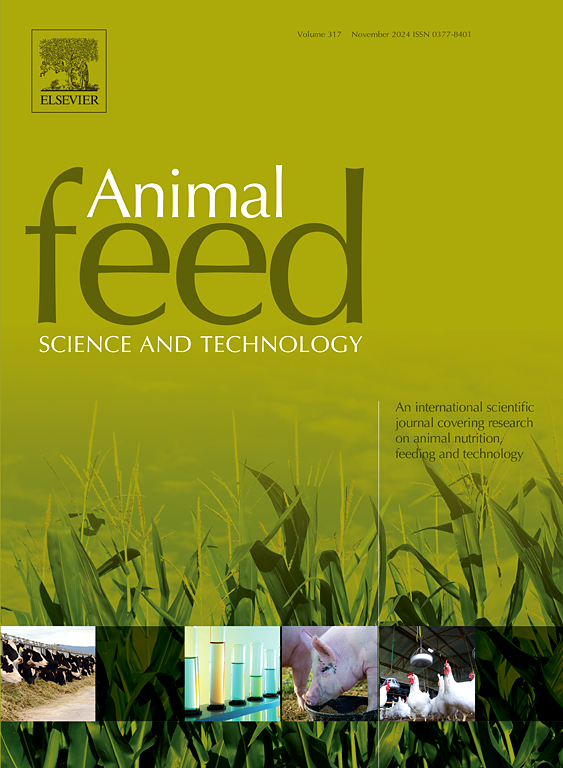Effects of niacin supplementation in a high-concentrate diet on growth performance, nutrient digestibility, and microbial protein synthesis of finishing lambs
IF 2.7
2区 农林科学
Q1 AGRICULTURE, DAIRY & ANIMAL SCIENCE
引用次数: 0
Abstract
Long-term feeding of high-concentrate diets will lead to rumen metabolic dysfunction, oxidative stress and inflammation of ruminants, and affect production performance. Niacin (NA) has been shown to mitigate these adverse effects by regulating the rumen environment and alleviating damage to the gastrointestinal barrier caused by high-concentrate diets. The present study was conducted to investigate the effects of niacin supplementation on growth performance, nutrient digestibility, nitrogen balance, and microbial protein (MCP) synthesis in lambs fed a high-concentrate diet. A total of forty-eight 1/2 Dorper × 1/2 thin-tailed Han crossbred male lambs (means body weight (BW) of 22.8 ± 1.86 kg) were divided into four levels (0, 400, 800, and 1200 mg/kg diet dry matter) of NA supplementation in lamb diet, respectively control (CON), 400NA, 800NA, and 1200NA. After the adaptation period, the feeding experiment lasted for 60 days, and then six lambs in each group were randomly selected for the digestion and metabolism trial. The results showed that average daily gain (ADG) during 30–60 days and the whole feeding period increased linearly with the increase of niacin supplementation (P < 0.05), and the dry matter intake (DMI) tended to increase linearly (P = 0.098). Dietary NA supplementation significantly increased rumen pH value (P < 0.05), with the 800NA group exhibiting significantly higher pH value compared to the CON group at 1, 3, 4, 6, 8, 10, and 12 hours post-feeding (P < 0.05). In particular, ruminal pH values showed a positive quadratic (P < 0.05) response with incremental levels of NA at 8, 10, and 12 hours post-feeding, and the highest pH value was observed in the 800NA group. As the dietary supplementation with niacin increased, the digestibility of dry matter (DM), organic matter (OM), crude protein (CP), and neutral detergent fiber (NDF) linearly increased (P < 0.05), and gross energy and nitrogen intake (N intake) also increased linearly (P < 0.05). The energy loss in feces, urine, and methane (CH4) was not affected by niacin supplementation (P > 0.05). Niacin supplementation linearly decreased the feces and urinary nitrogen (g/kg nitrogen-intake) (P < 0.05), thus, the retained nitrogen linearly increased (P < 0.05). In addition, the total urine purine derivatives (PDs) and the estimated MCP increased linearly with increasing niacin levels (P < 0.05). Overall, the administration of niacin to finishing lambs fed a high-concentrate diet resulted in enhanced nutrient utilization and MCP synthesis, thereby promoting superior growth performance.
在高浓缩日粮中添加烟酸对育成羔羊生长性能、营养物质消化率和微生物蛋白质合成的影响
长期饲喂高浓缩日粮会导致反刍动物瘤胃代谢功能紊乱、氧化应激和炎症,并影响生产性能。研究表明,烟酸(NA)可通过调节瘤胃环境和减轻高浓缩日粮对胃肠道屏障的破坏来减轻这些不良影响。本研究旨在探讨补充烟酸对饲喂高浓缩日粮的羔羊的生长性能、养分消化率、氮平衡和微生物蛋白(MCP)合成的影响。将48只1/2多尔帕×1/2细尾汉杂交雄性羔羊(平均体重(BW)为22.8 ± 1.86 kg)分为四个水平(0、400、800和1200 mg/kg日粮干物质),分别饲喂对照组(CON)、400NA、800NA和1200NA日粮。适应期结束后,饲喂试验持续 60 天,然后每组随机选择 6 只羔羊进行消化代谢试验。结果表明,随着烟酸添加量的增加,30-60 天和整个饲养期的平均日增重(ADG)呈线性增加(P < 0.05),干物质采食量(DMI)也呈线性增加趋势(P = 0.098)。日粮中添加NA可明显提高瘤胃pH值(P < 0.05),800NA组在饲喂后1、3、4、6、8、10和12小时的pH值明显高于CON组(P < 0.05)。尤其是在饲喂后 8、10 和 12 小时,瘤胃 pH 值随着 NA 水平的增加呈正二次方响应(P < 0.05),800NA 组的 pH 值最高。随着烟酸日粮添加量的增加,干物质(DM)、有机物(OM)、粗蛋白(CP)和中性洗涤纤维(NDF)的消化率呈线性增加(P <0.05),总能量和氮摄入量(N摄入量)也呈线性增加(P <0.05)。粪便、尿液和甲烷(CH4)中的能量损失不受烟酸补充的影响(P> 0.05)。补充烟酸可使粪氮和尿氮(克/千克摄氮量)呈线性下降(P <0.05),因此,潴留氮呈线性增加(P <0.05)。此外,尿液总嘌呤衍生物(PDs)和估计的 MCP 随烟酸水平的增加而线性增加(P < 0.05)。总之,对饲喂高浓缩日粮的育成羔羊施用烟酸可提高营养物质的利用率和 MCP 的合成,从而促进其获得优异的生长性能。
本文章由计算机程序翻译,如有差异,请以英文原文为准。
求助全文
约1分钟内获得全文
求助全文
来源期刊

Animal Feed Science and Technology
农林科学-奶制品与动物科学
CiteScore
6.00
自引率
6.20%
发文量
266
审稿时长
3 months
期刊介绍:
Animal Feed Science and Technology is a unique journal publishing scientific papers of international interest focusing on animal feeds and their feeding.
Papers describing research on feed for ruminants and non-ruminants, including poultry, horses, companion animals and aquatic animals, are welcome.
The journal covers the following areas:
Nutritive value of feeds (e.g., assessment, improvement)
Methods of conserving and processing feeds that affect their nutritional value
Agronomic and climatic factors influencing the nutritive value of feeds
Utilization of feeds and the improvement of such
Metabolic, production, reproduction and health responses, as well as potential environmental impacts, of diet inputs and feed technologies (e.g., feeds, feed additives, feed components, mycotoxins)
Mathematical models relating directly to animal-feed interactions
Analytical and experimental methods for feed evaluation
Environmental impacts of feed technologies in animal production.
 求助内容:
求助内容: 应助结果提醒方式:
应助结果提醒方式:


